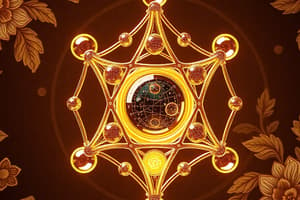Podcast
Questions and Answers
What intermolecular forces are primarily responsible for the solubility of small ester molecules in water?
What intermolecular forces are primarily responsible for the solubility of small ester molecules in water?
Dipole-Dipole intermolecular forces.
Explain the significance of delocalised electrons in the benzene molecule.
Explain the significance of delocalised electrons in the benzene molecule.
Delocalised electrons provide extra stability to the benzene molecule.
List two examples of organic compounds mentioned that are made in laboratories.
List two examples of organic compounds mentioned that are made in laboratories.
Ibuprofen and Vanillin.
What is the purpose of using anti-bumping granules in the steam generator during the distillation process?
What is the purpose of using anti-bumping granules in the steam generator during the distillation process?
Why must the steam generator be topped up with hot water during the distillation process?
Why must the steam generator be topped up with hot water during the distillation process?
What observation can be made about the distillate collected in the extraction of clove oil?
What observation can be made about the distillate collected in the extraction of clove oil?
Describe the bonding arrangement of carbon atoms in a benzene ring.
Describe the bonding arrangement of carbon atoms in a benzene ring.
What role do esters play in the food and cosmetic industry?
What role do esters play in the food and cosmetic industry?
What method is used to isolate clove oil from an emulsion of clove oil and water?
What method is used to isolate clove oil from an emulsion of clove oil and water?
In the extraction process, what is the purpose of shaking the mixture in the dropping funnel?
In the extraction process, what is the purpose of shaking the mixture in the dropping funnel?
What should be done after shaking the mixture in the dropping funnel to ensure safety?
What should be done after shaking the mixture in the dropping funnel to ensure safety?
What does the organic layer collected after the extraction contain?
What does the organic layer collected after the extraction contain?
How is the cyclohexane separated from the clove oil after extraction?
How is the cyclohexane separated from the clove oil after extraction?
What is the structural difference between primary and secondary alcohols?
What is the structural difference between primary and secondary alcohols?
What is an emulsion?
What is an emulsion?
What safety precaution should be taken when handling clove oil during the extraction process?
What safety precaution should be taken when handling clove oil during the extraction process?
What property of small alcohol molecules allows them to be soluble in water?
What property of small alcohol molecules allows them to be soluble in water?
How do the boiling points of aldehydes compare to their corresponding alkanes and alcohols?
How do the boiling points of aldehydes compare to their corresponding alkanes and alcohols?
What is the effect of increasing carbon chain length on the solubility of carboxylic acids in water?
What is the effect of increasing carbon chain length on the solubility of carboxylic acids in water?
What is the general formula for a carboxylic acid?
What is the general formula for a carboxylic acid?
Describe the basic structure of an ester.
Describe the basic structure of an ester.
What defines a condensation reaction, specifically in the context of ester formation?
What defines a condensation reaction, specifically in the context of ester formation?
Why are small ketones soluble in water?
Why are small ketones soluble in water?
How is the name of an ester determined based on its components?
How is the name of an ester determined based on its components?
What is the naming convention for aldehydes derived from the parent alkanes?
What is the naming convention for aldehydes derived from the parent alkanes?
In what way do carboxylic acids' boiling points compare to those of aldehydes and ketones?
In what way do carboxylic acids' boiling points compare to those of aldehydes and ketones?
What is a chloroalkane, and how is it structurally defined?
What is a chloroalkane, and how is it structurally defined?
What is the general formula for alcohols, and how do they differ from alkanes?
What is the general formula for alcohols, and how do they differ from alkanes?
Define primary, secondary, and tertiary alcohols based on the carbon's bond structure.
Define primary, secondary, and tertiary alcohols based on the carbon's bond structure.
Explain the process of making ethanol through fermentation.
Explain the process of making ethanol through fermentation.
What is the significance of adding methanol to ethanol in industrial contexts?
What is the significance of adding methanol to ethanol in industrial contexts?
Discuss the solubility characteristics of chloroalkanes.
Discuss the solubility characteristics of chloroalkanes.
How does the boiling point of alcohols compare to that of their corresponding alkanes?
How does the boiling point of alcohols compare to that of their corresponding alkanes?
Identify one common use of chloroalkanes in everyday applications.
Identify one common use of chloroalkanes in everyday applications.
Flashcards
Ester Dipole-Dipole Forces
Ester Dipole-Dipole Forces
Ester molecules have a polar carbonyl group (C=O), which creates intermolecular dipole-dipole forces.
Ester Solubility in Water
Ester Solubility in Water
Small ester molecules can dissolve in water due to their dipole-dipole forces.
Ester Uses
Ester Uses
Esters are used in food flavourings and perfumes/cosmetics to create fruity flavors.
Benzene Carbon Bonding
Benzene Carbon Bonding
Signup and view all the flashcards
Benzene Stability
Benzene Stability
Signup and view all the flashcards
Steam Distillation
Steam Distillation
Signup and view all the flashcards
Steam Distillation Experiment Setup
Steam Distillation Experiment Setup
Signup and view all the flashcards
Clove Oil Extraction
Clove Oil Extraction
Signup and view all the flashcards
Tetrahedral Carbon
Tetrahedral Carbon
Signup and view all the flashcards
Chloroalkane
Chloroalkane
Signup and view all the flashcards
Functional Group
Functional Group
Signup and view all the flashcards
Alcohol
Alcohol
Signup and view all the flashcards
Primary Alcohol
Primary Alcohol
Signup and view all the flashcards
Secondary Alcohol
Secondary Alcohol
Signup and view all the flashcards
Tertiary Alcohol
Tertiary Alcohol
Signup and view all the flashcards
Ethanol
Ethanol
Signup and view all the flashcards
Emulsion
Emulsion
Signup and view all the flashcards
Liquid-Liquid Extraction
Liquid-Liquid Extraction
Signup and view all the flashcards
Cyclohexane
Cyclohexane
Signup and view all the flashcards
Aqueous Layer
Aqueous Layer
Signup and view all the flashcards
Organic Layer
Organic Layer
Signup and view all the flashcards
Anhydrous Sodium Sulfate
Anhydrous Sodium Sulfate
Signup and view all the flashcards
Clove Oil (Eugenol)
Clove Oil (Eugenol)
Signup and view all the flashcards
Hydrogen Bonding in Alcohols
Hydrogen Bonding in Alcohols
Signup and view all the flashcards
Solubility of Alcohols
Solubility of Alcohols
Signup and view all the flashcards
Planar Carbon
Planar Carbon
Signup and view all the flashcards
Aldehydes: Functional Group
Aldehydes: Functional Group
Signup and view all the flashcards
Aldehydes: Naming
Aldehydes: Naming
Signup and view all the flashcards
Ketones: Functional Group
Ketones: Functional Group
Signup and view all the flashcards
Carboxylic Acids: Functional Group
Carboxylic Acids: Functional Group
Signup and view all the flashcards
Esters: Functional Group
Esters: Functional Group
Signup and view all the flashcards
Esterification Reaction
Esterification Reaction
Signup and view all the flashcards
Naming Esters
Naming Esters
Signup and view all the flashcards
Study Notes
Organic Compounds - Tetrahedral Compounds
- A tetrahedral carbon atom has four single bonds.
- Chloroalkanes: Hydrogen atoms in an alkane molecule are replaced by chlorine atoms.
- Uses: Solvents for removing grease and oil, dry cleaning.
- Properties: Weakly polar, insoluble in water, soluble in non-polar solvents (like cyclohexane), liquids at room temperature.
- Trichloromethane (chloroform) and tetrachloromethane are examples.
Organic Compounds - Alcohols
- Definition: Functional group responsible for characteristic properties.
- Formed by replacing a hydrogen atom in an alkane with an -OH group (hydroxyl group).
- General formula: CnH2n+1OH
- Named by changing the -e in alkanes to -ol
- Primary Alcohol: Carbon atom attached to -OH group is attached to only one other carbon atom.
- Secondary Alcohol: Carbon atom attached to -OH group is attached to two other carbon atoms.
- Tertiary Alcohol: Carbon atom attached to -OH group is attached to three other carbon atoms.
- Ethanol (ethyl alcohol): Found in alcoholic drinks, produced by fermenting glucose.
- Boiling points: Higher than corresponding alkanes due to hydrogen bonding.
- Solubility in water: Small alcohols are soluble, larger ones are less soluble.
Organic Compounds - Planar Compounds
- Planar carbon: Has planar geometry, unsaturated (contains a double or triple bond).
Organic Compounds - Aldehydes
- Homologous series: Organic compounds with -CHO functional group (aldehyde group).
- Naming: Change the -e of the parent alkane to -al.
- Dipole-dipole interactions: Boiling points are higher than corresponding alkanes due to dipole-dipole forces.
Organic Compounds - Ketones
- Homologous series: Organic compounds with a >C=O functional group called a carbonyl group.
- Naming: Change the -e of the parent alkane to -one.
- Carbonyl group is on a central carbon, never at an end.
- Dipole-dipole forces: Boiling points are higher than corresponding alkanes.
- Solubility in water: Small ketones are soluble.
Organic Compounds - Carboxylic Acids
- Family of organic compounds containing the carboxyl group (-COOH).
- Naming: Changing the -e of the parent alkane to -oic acid.
- Highly polar carbonyl group (-C=O) is always at the end of the chain.
- Strong hydrogen bonding: Higher boiling points than alkanes, alcohols, aldehydes, and ketones.
- Solubility in water: Small carboxylic acids are soluble.
Organic Compounds - Esters
- Family of compounds with the general formula RCOOR' (with a COO- group).
- Formed by reaction between an alcohol and carboxylic acid.
- Naming: Using the alcohol part first, then changing -oic acid to -oate.
- Dipole-dipole forces: Small esters are soluble.
- Used in flavors and perfumes.
Organic Compounds - Aromatic Compounds (Benzene)
- Each carbon atom in benzene ring has four electrons in its outer shell.
- Each carbon atom uses three of these to form sigma bonds with adjacent carbon atoms, and one adjacent hydrogen atom.
- The remaining valence electron is shared between all 6 carbon atoms, resulting in delocalized electrons, extra stability.
- Bond lengths between carbon atoms are equal.
Studying That Suits You
Use AI to generate personalized quizzes and flashcards to suit your learning preferences.




